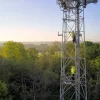BT Claim Broadband Investment to Boost Northern Ireland by £1.2bn
A new “independent” DotEcon study, which was commissioned by BT, has predicted that last year’s agreement to invest an additional £150m of state aid into improving the availability of “ultrafast broadband” (100Mbps+) across Northern Ireland could result in economic, social and environmental benefits worth £1.2bn.
Back in 2017 the Conservative UK government agreed to hand £75m per year (over two years) to “help provide ultra-fast broadband” (100Mbps+) across Northern Ireland, which formed part of a political deal with the Democratic Unionist Party (DUP) in order to secure the support of their 10 MPs.
Progress has been slow since last year, which is partly due to the on-going political deadlock, but N.Ireland’s Department for the Economy (DfE) are at least preparing to start a new consultation on the investment (here). Naturally BT will be keen to grab a slice of the action and so it doesn’t hurt to be associated with another optimistic economic forecast.
Advertisement
The report itself claims to assess the potential benefits that could result from an “investment focused in rural areas” and estimates that, for every £1 invested, there would be a benefit of around £8 to the local economy over 15 years. Key beneficiaries would be the disadvantaged Fermanagh and Omagh District and Mid-Ulster District Council areas.
Apparently increased employment would be the “largest source of benefit“, amounting to £890 million by 2033 (roughly £6 for every £1 invested).
Mairead Meyer, MD of BT’s N.Ireland Networks, said:
“We welcome the proposed investment and expansion of fibre broadband across Northern Ireland.
We await the publication of government plans for the proposed investment and acknowledge that, once they are announced, there will be a public and competitive procurement process. However, we wanted to investigate and share the economic impact such an investment would have, particularly within challenging, harder to reach rural areas across Northern Ireland.
This report highlights the huge potential of an expansion of ultrafast fibre broadband in rural areas and how it could open a wealth of opportunities, futureproofing our infrastructure and enabling Northern Ireland to compete alongside the best fibre networks in Europe.”
As it stands N.I already has universal coverage of so-called “fibre broadband” based networks (mostly FTTC with some FTTP or Cable DOCSIS) but only around 86% of premises can actually access “superfast broadband” speeds of 24Mbps+ via those. This drops to a little over 30% for those within reach of an “ultrafast” connection and at present the latter is mostly thanks to Virgin Media.
However we do have a few bones to pick with the report, such as the fact that on page 4 and 9 it appears to confuse the definitions of “superfast broadband” (usually either 24Mbps+ or 30Mbps+) with “ultrafast broadband” (100Mbps+).
Advertisement
BT’s Roll-out Plan for the Investment
BT is supportive of the proposed investment in ultrafast broadband, outlined under the DUP and Conservative Confidence & Supply Arrangement, which will see £150m of public funds allocated to a public procurement. This would extend the availability of ultrafast broadband with at least 30Mb/s download speed to about 140,000 additional households and business premises in rural areas of Northern Ireland.
…
BT’s roll out plans for the investment would see approximately 140,000 additional households and business premises provided with ultrafast broadband with download speeds of at least 30 Mb/s. The roll-out is phased but would be largely complete by 2021.
We estimate that roughly 6,900 business premises would benefit. Given the rural focus, we can expect these to mainly be small and micro businesses, plus some agriculture.
Later on the report then switches back to the normal definition and states, “We expect speeds in the order of 100Mb/s to be offered, with future upgrade paths to higher speeds being enabled.” We’re confused but the “target speed for each of the premises” does still seem to be 100Mbps+, despite the awkward language.
Another oddity is that the report title (‘Deployment of FTTP in rural Northern Ireland‘) clearly mentions “full fibre” FTTP broadband technology, although the entire rest of the report is more neutral in its language and only ever seems to use the now generic word “fibre” to describe its plan (this could conceivably also include hybrid fibre G.fast in some areas).
The figure of 140,000 is also interesting because BT has separately already begun to invest a further £20m across N.I in order to expand their coverage of “ultrafast broadband” services to a further 140k homes and businesses by March 2019 (here); reflecting 25% of the country, albeit mostly in urban rather than rural areas.
As we always say, it’s wise to take such predictions with a pinch of salt as gauging the economic impact of faster broadband connectivity is notoriously difficult.
Advertisement
Mark is a professional technology writer, IT consultant and computer engineer from Dorset (England), he also founded ISPreview in 1999 and enjoys analysing the latest telecoms and broadband developments. Find me on X (Twitter), Mastodon, Facebook, BlueSky, Threads.net and Linkedin.
« ORG Warns Many Court Ordered UK ISP Website Blocks are in Error
















































Comments are closed